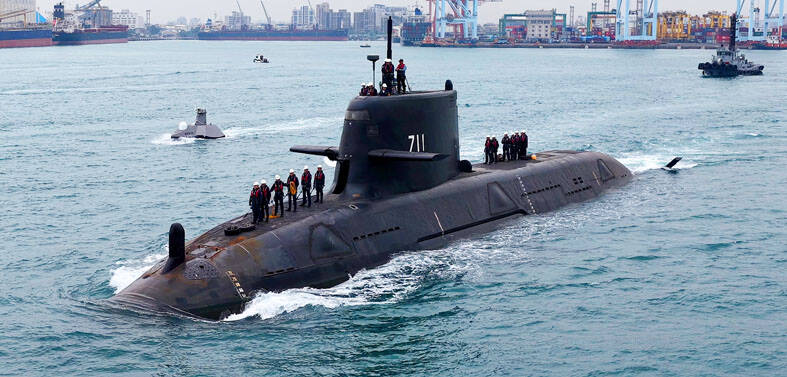A fighter plane being developed by the state-run Aerospace Industrial Development Corporation (AIDC) that is years behind in its development and has lost the interest of its only potential buyer was test-flown for the first time last week, the AIDC said yesterday.
Wednesday's test flight of the Tiger 2000 prototype, an upgraded version of the US-made F-5E fighter, was a success, according to its makers.
The prototype will be test-flown several more times starting in the middle of next month, the AIDC said.
The Tiger 2000 prototype took off from CCK Air Base near Taichung at 3:10pm on Wednesday.
Retired air force pilot Wu Kang-ming (
Wu was also the first to test fly the prototype of the domestically-built Indigenous Defense Fighter (IDF) in 1989.
"The test results were satisfactory," an official with the AIDC said.
"But more tests are needed to make sure that the capabilities of the plane will be as good and reliable as expected."
Although the test flight was a big step in the development of the Tiger 2000, the AIDC official said, it is not known whether the plane will go into production as initially planned.
"The test-flight of the prototype of the Tiger 2000 was conducted in the absence of the company's leader, Huang Jung-teh (黃榮德), an ex-deputy chief of the air force," the official said.
"We have yet to find out how Huang will handle the Tiger 2000 project. We can not be sure whether the project will continue, or end with the flight tests," he said.
The uncertainty stems from lack of interest in the plane shown by the air force, the only potential buyer of the Tiger 2000.
The air force originally intended to buy the plane, which was named after the year in which its development was scheduled to be completed.
But now the air force is planning to replace the Tiger 2000 purchase plan with another upgraded version of the F-5E that is cheaper and takes less time to build, sources said.
The fighter the air force is looking at would be largely the same as the original F-5E but with a modern radar system installed.
In comparison, the Tiger 2000 is much more difficult to construct since it requires a complete renewal of the plane's avionics and fire-control system.
The Tiger 2000 was aimed as an equivalent to the IDF, capable of carrying and firing the locally-developed medium-range Tien Chien-II air-to-air missile.
But the project, which originally seemed straightforward for the AIDC following its experience in developing the IDF, turned out to be a nightmare for the company.
The AIDC has spent the past four years overcoming problems in replacing the plane's complicated wiring systems and fixing the plane's engine.

US climber Alex Honnold is to attempt to scale Taipei 101 without a rope and harness in a live Netflix special on Jan. 24, the streaming platform announced on Wednesday. Accounting for the time difference, the two-hour broadcast of Honnold’s climb, called Skyscraper Live, is to air on Jan. 23 in the US, Netflix said in a statement. Honnold, 40, was the first person ever to free solo climb the 900m El Capitan rock formation in Yosemite National Park — a feat that was recorded and later made into the 2018 documentary film Free Solo. Netflix previewed Skyscraper Live in October, after videos

NUMBERS IMBALANCE: More than 4 million Taiwanese have visited China this year, while only about half a million Chinese have visited here Beijing has yet to respond to Taiwan’s requests for negotiation over matters related to the recovery of cross-strait tourism, the Tourism Administration said yesterday. Taiwan’s tourism authority issued the statement after Chinese-language daily the China Times reported yesterday that the government’s policy of banning group tours to China does not stop Taiwanese from visiting the country. As of October, more than 4.2 million had traveled to China this year, exceeding last year. Beijing estimated the number of Taiwanese tourists in China could reach 4.5 million this year. By contrast, only 500,000 Chinese tourists are expected in Taiwan, the report said. The report

Temperatures are forecast to drop steadily as a continental cold air mass moves across Taiwan, with some areas also likely to see heavy rainfall, the Central Weather Administration (CWA) said. From today through early tomorrow, a cold air mass would keep temperatures low across central and northern Taiwan, and the eastern half of Taiwan proper, with isolated brief showers forecast along Keelung’s north coast, Taipei and New Taipei City’s mountainous areas and eastern Taiwan, it said. Lows of 11°C to 15°C are forecast in central and northern Taiwan, Yilan County, and the outlying Kinmen and Lienchiang (Matsu) counties, and 14°C to 17°C

STEERING FAILURE: The first boat of its class is experiencing teething issues as it readies for acceptance by the navy, according to a recent story about rudder failure The Hai Kun (海鯤), the nation’s first locally built submarine, allegedly suffered a total failure of stern hydraulic systems during the second round of sea acceptance trials on June 26, and sailors were forced to manually operate the X-rudder to turn the submarine and return to port, news Web site Mirror Daily reported yesterday. The report said that tugboats following the Hai Kun assisted the submarine in avoiding collisions with other ships due to the X-rudder malfunctioning. At the time of the report, the submarine had completed its trials and was scheduled to begin diving and surfacing tests in shallow areas. The X-rudder,